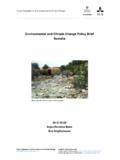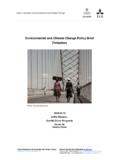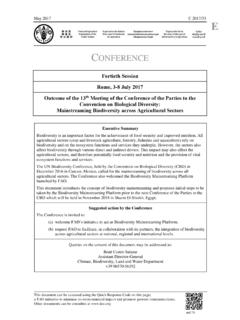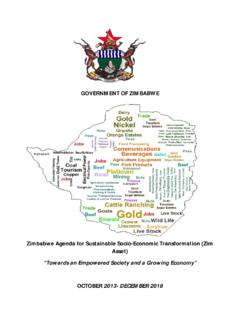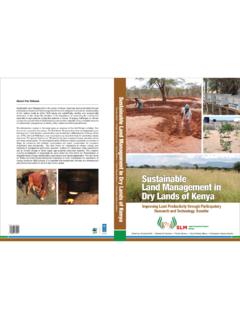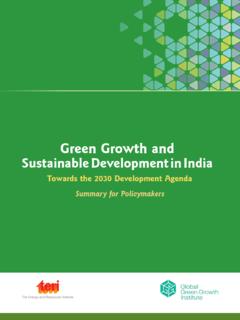Transcription of Zambia Environmental and Climate Change Policy …
1 Zambia Environmental and Climate Change Policy Brief1 Nov. 2010 Executive Summary This Environmental and Climate Change Policy Brief has been written as an input to the Poverty and Development Assessment that Sida is undertaking as part of the preparation of a revised Swedish cooperation strategy with Zambia . It aims at briefly presenting key Environmental sustainability challenges and opportunities (including Climate Change and disaster risk reduction) in Zambia , their linkages to poverty reduction and economic development and how they are addressed in the Zambian Sixth National Development Plan (SNDP). Opportunities for Sida and other development partners to supporting improved Environmental management are also briefly discussed. Due mainly to rampant deforestation Zambia is unlikely to achieve the Millennium Goal 7 on Environmental sustainability.
2 The deforestation rate is well above the global and regional average and is closely linked to other key Environmental problems such as land degradation, wildlife depletion and loss of biodiversity and ecosystem services. These problems constrain poor households income opportunities through lowering agricultural productivity and access to different non-timber forest products. Water- and air-pollution (indoor and outdoor) as well as the low access to clean water and sanitation have serious negative health implications for poor households in general and for children in particular. Environmental health factors play a very significant role for the low life expectancy and high child mortality and morbidity in Zambia . Poor households also have the least capacity to cope with food insecurity or economic shocks following natural disasters, which are likely to become more frequent with Climate Change .
3 Environmental degradation poses significant constraints to key growth sectors such as agriculture and tourism. Climate variability is estimated to reduce agricultural growth by 1% per year. Revenues from mining of finite natural resources have not been translated into human development, as indicated by the negative adjusted net savings in Zambia (a World Bank sustainability indicator). Loss of eco-system services and Environmental degradation is largely unaccounted for in national accounts and statistics, which imply that real economic growth most likely is significantly lower than what the GDP growth rate indicates. The continued Environmental degradation strongly indicates that the Zambian state largely fails to sustainably manage its environment and natural resources. The new National Policy on the Environment is supposed to address the scattered Policy and legal framework for environment and natural resources management, but if it is not backed by a strong political commitment and 1 This Environmental Analysis was written, at the request of the Sida Country Team for Zambia (Marie Ramm) in dialogue with the Sida Environment and Climate Change Team (Elisabeth Folkunger) by Daniel Slunge and Gunilla lund Wingqvist at the Environmental Economics Unit (EEU), Department of Economics, University of Gothenburg, as part of Sida-EEU s institutional collaboration on Environmental economics and strategic Environmental assessment, with contributions from SEI Oxford (Ben Smith).
4 Comments from H kan Berg, SwedBio, Carol B ckman, SLU and Eva Ohlsson, Sida on a previous draft are gratefully acknowledged. Further comments can be sent to The views expressed in the document are those of the authors and do not necessarily represent the views of Sida. 2 financial resources there is a clear risk that it will not be translated into practical action. The Ministry of Tourism, Environment and Natural Resources (MTENR) is in practice too weak to fulfil its mandate to coordinate environment and natural resources management. The lack of enforcement of national Environmental legislation is a key problem. Several Policy areas of key importance for environment and natural resources management are outside the confines of the MTENR, which underlines the importance of improved inter-sectoral collaboration and mainstreaming of environment and Climate Change in Zambia s core systems for planning and financial management.
5 The Environment and Natural Resources Management and Mainstreaming Programme (ENRMMP) is an important initiative aiming at both strengthening the MTENR and support Environmental mainstreaming. However, there may be a risk that the division of roles and responsibilities in accordance with JASZ reduces Environmental issues to a concern only for development partners working with MTENR. Development partners working with other sector ministries and Ministry of Finance and National Planning have a key role in promoting Environmental mainstreaming and addressing Environmental problems. In this context the lack of integration of Environmental concerns in the draft SNDP is a case for concern. Unlike the FNDP, the SNDP does not have an environment chapter, neither are there clear measurable targets and indicators relating to Environmental concerns.
6 Climate Change related concerns are on the other hand generally well addressed in the draft SNDP, which may be a reflection of the great attention to Climate Change lately. Development partners could play an important role through a continued dialogue with the government on Environmental integration in the SNDP. In such a dialogue it is important to point at the large opportunities to promote pro-poor growth through wiser and more pro-active management of Zambia s soils, waters, biodiversity and mineral resources. These opportunities include addressing deforestation through compensating farmers for ecosystem services that standing forests provide (REDD+) and promoting sustainable biofuel production. In order for both REDD+ and biofuel initiatives to be pro-poor and environmentally sustainable, careful planning and participation of local stakeholders is necessary.
7 Similarly, providing poor households with alternative energy sources ( solar, gas) could contribute to both reducing deforestation and health problems due to indoor air-pollution. Linking agriculture, health and energy sector interventions could potentially bring a range of similar opportunities and carbon finance and technology transfer may help increase access to and affordability of energy. Important opportunities for Climate Change adaptation which also can enhance food production and security include diversification of cropping, water-saving techniques, small-scale irrigation schemes and the further development of systems for seasonal forecasting. Finally, there is a need to put the specific governance challenges related to Environmental management into the broader perspective of weak governance in Zambia .
8 While the current Environmental degradation implies large costs to many poor stakeholders, there are also some stakeholders benefiting from the lack of implementation and enforcement of Environmental policies. Environmental governance is embedded in a complex political economy which may hamper reform efforts. Accountability initiatives that improve and transparency and access to Environmental information as well as strengthens actors, such as media, civil society and community based organizations, that can draw attention to Environmental problems and demand Environmental improvements can be very important in this situation. 3 Contents Executive Summary .. 1 1. Introduction .. 4 2. Key Environmental challenges, and their causes .. 5 3. What are the effects of the Environmental challenges on poverty and economic development?
9 6 Impacts on Poverty in urban and rural areas .. 6 Impacts on Public Health .. 7 Impacts on Economic Development and Key Sectors .. 9 4. Climate Change Mitigation and Adaptation .. 12 Mitigation .. 12 Adaptation .. 13 Disaster risk reduction .. 13 5. Policy framework and Key actors for managing environment and Climate Change challenges .. 14 Policy framework for managing environment and Climate Change challenges .. 14 Key Actors .. 15 Governance, implementation and enforcement .. 17 6. Constraints and Opportunities related to the Environment and Climate Change .. 18 Key Constraints .. 18 Key Opportunities .. 19 Opportunities for Sida and other development agencies .. 19 References .. 21 Appendix 1: Key Environmental challenges in Zambia .. 23 Appendix 2: Key Policy and legal documents for ENR management .. 26 4 1.
10 Introduction Zambia is richly endowed with a number of valuable natural resources including minerals, forests, wildlife and fertile land, which have played a crucial role for economic and political developments. As many other natural resource rich countries, Zambia has failed to translate natural resource rents into a broad based development and poverty reduction. Instead, resource extraction has been characterized by boom and bust cycles, rent-seeking behaviour and rampant degradation of the country s Environmental resources. As a consequence, Zambia remains one of the low-income countries in Africa with low levels of human development, and high levels of corruption. However, rich natural resource endowments do not need to be a curse for poor countries2. With appropriate institutions and policies, natural resources can be a source of wealth, as shown by the recent review - Creating and Protecting Zambia s Wealth Experiences and next steps in Environmental mainstreaming - led by the Ministry of Finance and National Planning (MFNP) and the Environmental Council of Zambia (ECZ)3.
